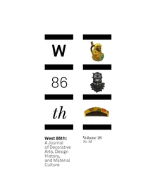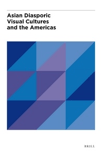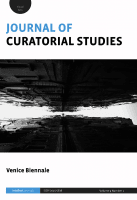
Journal of the History of Collections
Scope & Guideline
Documenting the evolution of collections across time.
Introduction
Aims and Scopes
- Exploration of Collector Profiles:
The journal frequently examines the lives and networks of individual collectors, emphasizing how personal tastes and social circumstances influence collection formation. - Historical Context of Collections:
Papers often contextualize collections within broader historical movements, exploring how art and artifacts were gathered, displayed, and valued in various epochs. - Interdisciplinary Approaches:
The journal embraces interdisciplinary methodologies, incorporating perspectives from art history, anthropology, sociology, and museum studies to examine collections and collecting. - Impact of Colonialism and Globalization:
A significant focus is placed on the implications of colonialism and globalization on collecting practices, including the ethical considerations surrounding looted artifacts and cultural appropriation. - Museum Studies and Curatorial Practices:
The journal investigates the evolution of museums and curatorial practices, discussing how collections are managed, interpreted, and presented to the public. - Material Culture Studies:
There is a strong emphasis on material culture, analyzing how objects reflect societal values and historical narratives through their collection and display.
Trending and Emerging
- Decolonization of Collections:
A growing body of research is focused on the decolonization of collections, addressing the need to confront colonial legacies in museum practices and the restitution of cultural artifacts to their countries of origin. - Digital Collecting and Virtual Exhibitions:
As the digital landscape evolves, there is an increasing exploration of digital collecting practices, virtual exhibitions, and the impact of technology on how collections are curated and accessed. - Environmental and Ethical Collecting:
Emerging studies are beginning to interrogate the environmental impacts and ethical considerations of collecting, particularly in relation to sustainability and the provenance of objects. - Collecting as Social Practice:
Research is increasingly framing collecting as a social practice, examining how community engagement and social networks influence collection formation and interpretation. - Intersectionality in Collecting Narratives:
There is a rising trend towards exploring intersectionality within collecting narratives, considering how factors such as gender, race, and class shape the practices and experiences of collectors.
Declining or Waning
- Focus on Traditional Art Movements:
There has been a noticeable decrease in papers centered solely on traditional art movements without a broader contextual analysis of collecting practices, suggesting a shift towards more interdisciplinary and contextualized studies. - Local and Regional Collecting Practices:
Research focusing specifically on localized or regional collecting practices has diminished, possibly overshadowed by more global perspectives that emphasize transnational networks and movements. - Connoisseurship and Attribution Studies:
The emphasis on connoisseurship and the attribution of artworks has waned, reflecting a broader critique of traditional art historical methodologies that privilege expert opinion over collective narratives. - The Role of Private Collectors:
Discussions solely focused on the role of private collectors in isolation from institutional contexts are becoming less frequent, indicating a trend towards integrating private and public collecting narratives. - Static Historical Accounts:
Papers that offer static historical accounts of collections without engaging with contemporary issues or ongoing debates in the field are appearing less frequently, as scholars seek to connect historical practices with current ethical considerations.
Similar Journals

West 86th-A Journal of Decorative Arts Design History and Material Culture
Connecting Past and Present Through DesignWest 86th: A Journal of Decorative Arts, Design History, and Material Culture, published by University of Chicago Press, stands as a significant publication within the arts and humanities, particularly focusing on the interconnections among decorative arts, design history, and material culture. With its ISSN 2153-5531 and E-ISSN 2153-5558, this journal has evolved since its inception in 2011, diligently contributing to a deeper understanding of visual arts and their historical context. Although categorized in the fourth quartile for the year 2023 within Visual Arts and Performing Arts, it ranks #387 out of 667 in Scopus, showcasing a unique niche with a commitment to quality scholarship. Researchers, professionals, and students engaged in these dynamic fields are encouraged to explore this journal as it provides insightful analyses and discussions that enrich the dialogue on the significance and impact of material culture. While it is not open access, the journal’s contributions remain integral for those seeking to deepen their knowledge and appreciation of decorative arts and design history.

Asian Diasporic Visual Cultures and the Americas
Bridging Cultures: The Art of Asian Diasporas in the AmericasAsian Diasporic Visual Cultures and the Americas is a pioneering journal published by BRILL, dedicated to exploring the intersections of visual culture, identity, and diaspora within the context of the Americas. With an ISSN of 2352-3077 and E-ISSN of 2352-3085, this journal has established itself as a significant resource for academics, researchers, and students interested in the visual arts and their broader social implications. Since its inception in 2015, the journal has been committed to fostering interdisciplinary dialogue, providing a platform for innovative research that examines how Asian diasporic communities express their identities through visual mediums. Despite its relatively recent establishment, it endeavors to challenge and expand the narratives related to visual arts in a diverse and globalized world. Though the journal currently does not offer open access options, it remains a vital asset for those engaged in understanding the critical dynamics of race, ethnicity, and culture in contemporary visual practices. Converging insights from both the arts and social sciences, this journal invites contributions that illuminate the complexities of diasporic experiences, making it a pertinent choice for those aiming to contribute to this evolving field.

Religion and the Arts
Fostering Innovative Perspectives on Religion and the ArtsReligion and the Arts is a distinguished scholarly journal published by BRILL, based in the Netherlands, with a dedicated focus on the interdisciplinary exploration of religion and its interplay with various artistic expressions from historical and contemporary perspectives. Established in 1996, this journal serves as a vital platform for researchers, professionals, and students interested in Cultural Studies, History, Religious Studies, and the Visual and Performing Arts. Despite its current classification in the Q4 category across multiple fields, it remains committed to advancing academic discourse and fostering innovative approaches to understanding the complex relationships between spirituality and artistic creation. With its ISSN 1079-9265 and E-ISSN 1568-5292, the journal invites submissions that contribute to enriching this dynamic field, ensuring that a diverse range of voices and perspectives are represented. Although not an Open Access publication, the journal’s content continues to be pivotal for scholarly engagement and is essential reading for those dedicated to the study of art's profound connections with religious traditions.

Zivot Umjetnosti
Fostering critical dialogue in the realm of artistic research.Zivot Umjetnosti, published by the INST POVIJEST UMJETNOSTI - INST ART HISTORY, is a notable Croatian journal that serves as a platform for scholarly discourse in the fields of visual arts, performing arts, and museology. With its inception in 2008, the journal has continued to provide a voice for researchers and practitioners alike, contributing significantly to ongoing conversations in the arts. Despite its current Q4 rank in both Visual Arts and Museology categories—placing it within the 21st and 17th percentiles, respectively—Zivot Umjetnosti is recognized for its commitment to advancing knowledge and fostering critical dialogue. The journal aims to bridge theoretical frameworks with practical applications, making it an invaluable resource for academics, curators, and students engaged in artistic research. While currently operating under traditional access options, Zivot Umjetnosti remains a fundamental publication for those wishing to explore and expand their understanding of the dynamic intersection of art and culture in Croatia and beyond.

Bulletin KNOB
Connecting Scholars, Preserving HistoryBulletin KNOB, published by the KONINKLIJKE NEDERLANDSE OUDHEIDKUNDIGE BOND-KNOB, is a reputable Open Access journal that has been disseminating knowledge since 1899, with a continued commitment to making research accessible to all. Based in the Netherlands, this journal provides a platform for scholarly articles that span the fields of Conservation, History, and the Visual Arts and Performing Arts. With its 2023 Scopus rankings placing it in the top quartiles within its category, Bulletin KNOB is recognized for its significant contribution to the advancement of these disciplines. Researchers, professionals, and students alike are encouraged to engage with the journal's diverse content that bridges historical narratives with contemporary practices, fostering a deeper understanding of cultural heritage. The journal’s commitment to excellence is further reflected in its Q3 and Q4 quartile rankings, making it an essential resource for anyone dedicated to the study of the arts and humanities.

Journal of Curatorial Studies
Unveiling Insights into the Dynamic World of CuratorshipThe Journal of Curatorial Studies, published by INTELLECT LTD, is a leading scholarly journal dedicated to advancing the field of curatorial practice across the visual arts, museology, and conservation. With an ISSN of 2045-5836 and an E-ISSN of 2045-5844, this UK-based publication has been a vital resource since its establishment in 2016, covering significant developments and innovative research until 2023. As an academic platform, it seeks to foster interdisciplinary dialogue among curators, artists, and scholars, exploring contemporary challenges and methodologies within its scope. Ranking in the Q4 category for Conservation and Q3 for both Museology and Visual Arts and Performing Arts, the journal plays an essential role in elevating discourse and practice within these fields. Researchers and practitioners alike will find valuable insights that reflect the dynamic nature of curatorial studies and its profound influence on cultural heritage and contemporary art. Despite its recent establishment, it holds a commendable position in the Scopus Rankings, aiming to provide a rich repository of knowledge and practical guidance in its quest to innovate curatorial practices.

Umeni-Art
Exploring the Intersection of Art and ScholarshipUmeni-Art is a prominent journal in the field of visual arts and performing arts, published by the Institute of Art History, Academy of Sciences, Czech Republic. With its ISSN 0049-5123 and E-ISSN 1804-6509, the journal has established itself as a critical platform for scholarly discourse and artistic expression since its inception in 2002. Although currently classified in Q4 within the Arts and Humanities category, it aims to elevate the understanding and appreciation of the arts through rigorous research and innovative perspectives. The journal's Scopus ranking places it at Rank #573/667, reflecting its growing contribution to the field and expanding reach within the artistic community. With a focus on fostering collaboration among researchers, practitioners, and students, Umeni-Art seeks to enrich the academic landscape with significant findings and discussions that inspire future research and creative endeavors. While it does not offer open access, the journal remains a valuable resource for those vested in exploring the dynamic interplay between art, culture, and society in the contemporary context.

Quiroga-Revista de Patrimonio Iberoamericano
Advancing Knowledge in Cultural Preservation and Artistic ExpressionQuiroga-Revista de Patrimonio Iberoamericano, published by UNIV GRANADA, is a distinguished open-access journal dedicated to the fields of conservation, museology, and the visual and performing arts. Since its inception in 2012, the journal has provided a platform for scholars and practitioners to disseminate innovative research and critical discussions pertinent to Ibero-American heritage. With a growing impact, evidenced by its category quartiles ranking—Q3 in Conservation and Q2 in both Museology and Visual Arts and Performing Arts—as well as its Scopus rankings, Quiroga serves as an essential resource for researchers, professionals, and students who engage with the complexities of cultural preservation and artistic expression. The journal’s commitment to open access ensures the widespread availability of knowledge, fostering academic dialogue and collaboration within the global community. For inquiries, the journal can be reached at their offices located in Granada, Spain.

OUD HOLLAND is a prestigious journal published by BRILL, focusing on the rich history and developments in the visual arts and performing arts. With a historical lineage dating back to its initial publication years from 1883 and periodic revivals until 2024, this journal has maintained its relevance amidst evolving artistic discourse. It holds an impressive standing in the Arts and Humanities field, ranking 338 out of 667 in the Visual Arts and Performing Arts category, positioning it comfortably within the 49th percentile. The journal disseminates critical research and insightful articles that cater to scholars, professionals, and students dedicated to advancing their understanding of artistic heritage and contemporary methodologies. Though currently not open access, OUD HOLLAND represents an invaluable resource for those committed to exploring the multifaceted dimensions of art, offering access to a wealth of knowledge grounded in meticulous research and scholarship.

Journal of Belgian History-Revue Belge d Histoire Contemporaine-Belgisch Tijdschrift voor Nieuwste Geschiedenis
Revealing the Stories that Shaped BelgiumThe Journal of Belgian History-Revue Belge d'Histoire Contemporaine-Belgisch Tijdschrift voor Nieuwste Geschiedenis is a prominent academic publication dedicated to the exploration and analysis of contemporary Belgian history. Published by SOMA-CEGES, this journal serves as a vital resource for researchers, professionals, and students alike, providing a platform for scholarly discourse and the dissemination of innovative research in the field. Despite its historical significance, the journal faced a hiatus in its Scopus coverage from 2019, yet it retains a strong identity within the Arts and Humanities category, holding a Scopus rank of #1123 out of 1328, placing it in the 15th percentile. This underscores the opportunities for growth and impactful contributions within the journal's scope. By focusing on the intricacies of Belgian history, the journal encourages rigorous investigation and a deeper understanding of Belgium's past, making it an essential reference for anyone interested in European historical narratives.